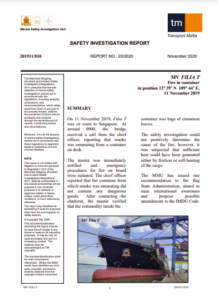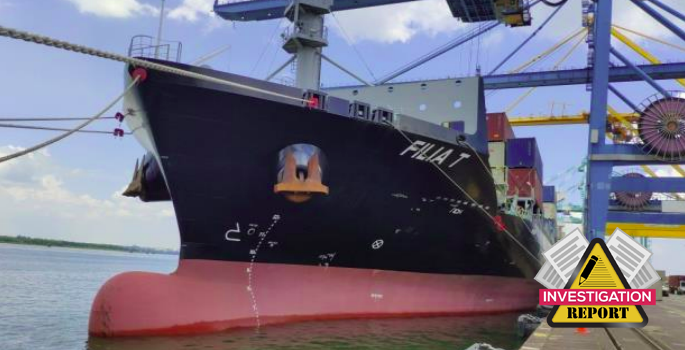Transport Malta issued an investigation report on the fire on container onboard the ship Filia T while en route to Singapore in November 2019. The report could not determine the exact cause of the fire but identifies either friction or self-heating of the cargo as probable causes.
The investigation of this incident comes amid a worrying trend of container ship fires worldwide. To address the issue, five partners in the Cargo Integrity Group, including Container Owners Association (COA), the Global Shippers Forum (GSF), the International Cargo Handling Co-ordination Association (ICHCA), the TT Club and the World Shipping Council (WSC) issued a guide in September, to serve as a route-map for the CTU Code and to assist wider understanding of good packing practices.
The incident
On 11 November 2019, Filia T was en route to Singapore. At around 0900, the bridge received a call from the chief officer, reporting that smoke was emanating from a container on deck. The master was immediately notified and emergency procedures for fire onboard were initiated.
The chief officer reported that the container from which smoke was emanating did not contain any dangerous goods.
After contacting the charterer, the master verified that the commodity inside the container was bags of cinnamon leaves.
Probable cause of the fire
The investigation could not positively determine the cause of the fire, however, it was suspected that sufficient heat could have been generated either by friction or self-heating of the cargo.
Four elements are required to start a fire – a sufficient supply of oxygen, a combustible material, sufficient heat to raise the temperature of the combustible material to its ignition temperature, and a subsequent exothermic chain reaction within the material.
Although closed, a dry cargo container is not gas-tight; therefore, air would have been able to enter the container, albeit not sufficient for the required ventilation, but enough to start and sustain a fire, as the dynamics of the events have shown.
The bags of dry cinnamon leaves, including the chemical constituents of the leaves, formed the combustible material and also provided for the subsequent exothermic chain reaction.
Heat was probably provided by either friction or self-heating of the cargo. As the condition of the cargo was not made available to the safety investigation, spontaneous combustion of the cargo, due to its inherent properties, was not excluded as another probable cause of the fire.
Conclusions
- Although the immediate cause of the fire was not positively established, the safety investigation hypothesized that sufficient heat could have been generated either by friction or selfheating of the cargo, leading to its combustion.
- The chemical constituents of the cargo were combustible.
- As the process of drying of the cargo was not made available, the safety investigation did not exclude the possibility that an adequate concentration of styrene was available to start a fire at a lower temperature.
- Guidelines for the transport of cinnamon leaves were not available, due to which the hazards of the cargo and the necessary precautions to be taken were not known.
- The container which caught fire was stowed on the vessel’s hatch cover, while the vessel was passing through a tropical area, where the temperatures and humidity levels were high.
- As the container used was a standard-type container, due to which adequate ventilation was not available, it is highly likely that the relative humidity and temperature within the container rose during the voyage, subsequently increasing the risk of self-heating of the cargo.
- The fire fighting carried out by the crew members was timely and effective to keep the fire under control.
Actions taken
Following this occurrence, the company carried out the following safety actions:
- Crew members were instructed to carry out frequent checks on containers which include temperature control. Any unjustifiable increase in temperature is to be reported to the Master and the Company.
- A safety alert was circulated to all interested parties to draw attention to this accident and to the flammable characteristics of cinnamon and the proper handling and stowage of similar types of cargo.
Recommendations
Transport Malta recommended the flag State Administration to review the findings of this safety investigation report with the aim of submitting a paper to the relevant IMO Sub-Committee for consideration to classify this cargo either as a Class 4.1 or Class 4.2 of the IMDG Code.
Explore more herebelow:































































